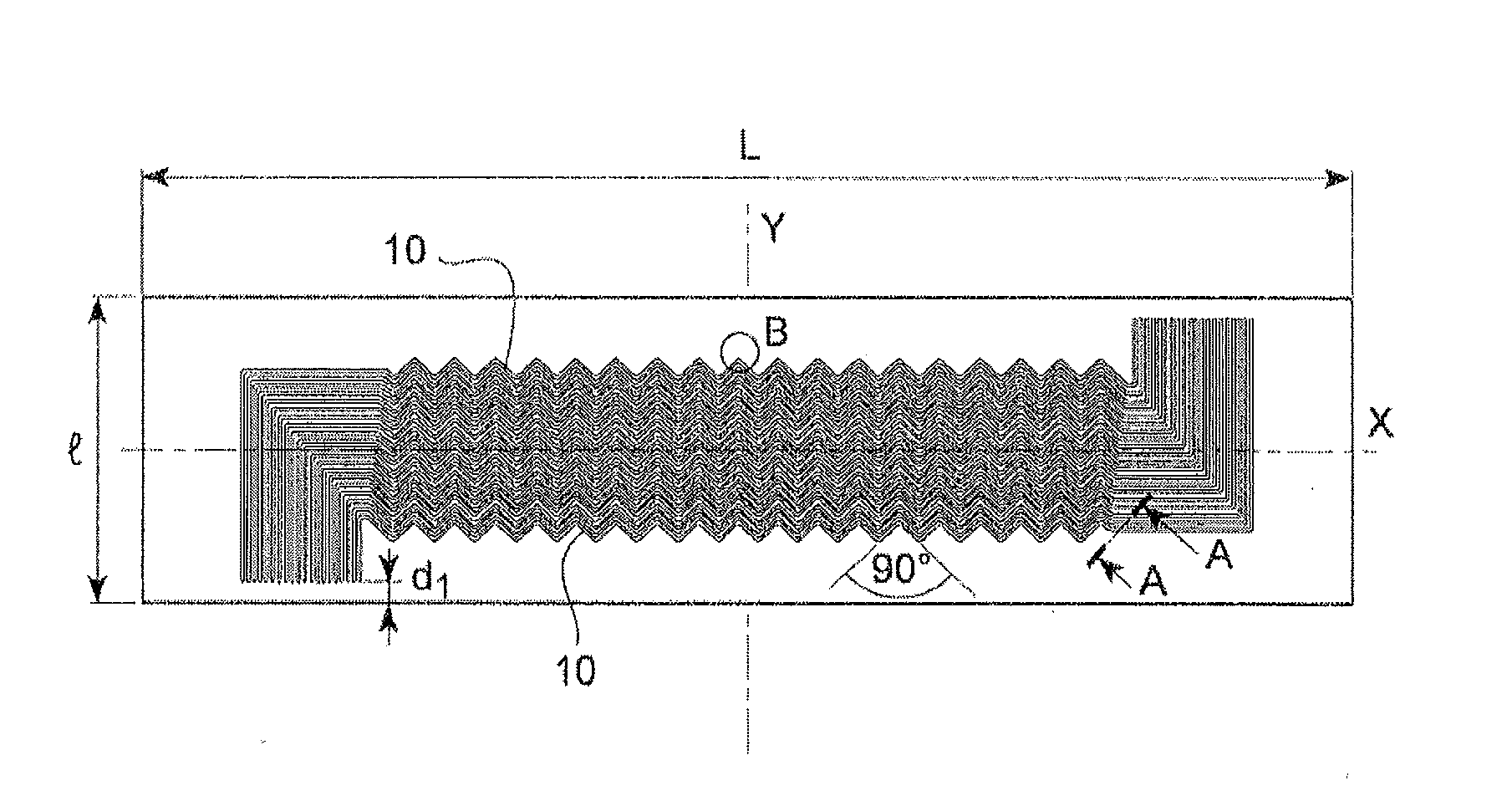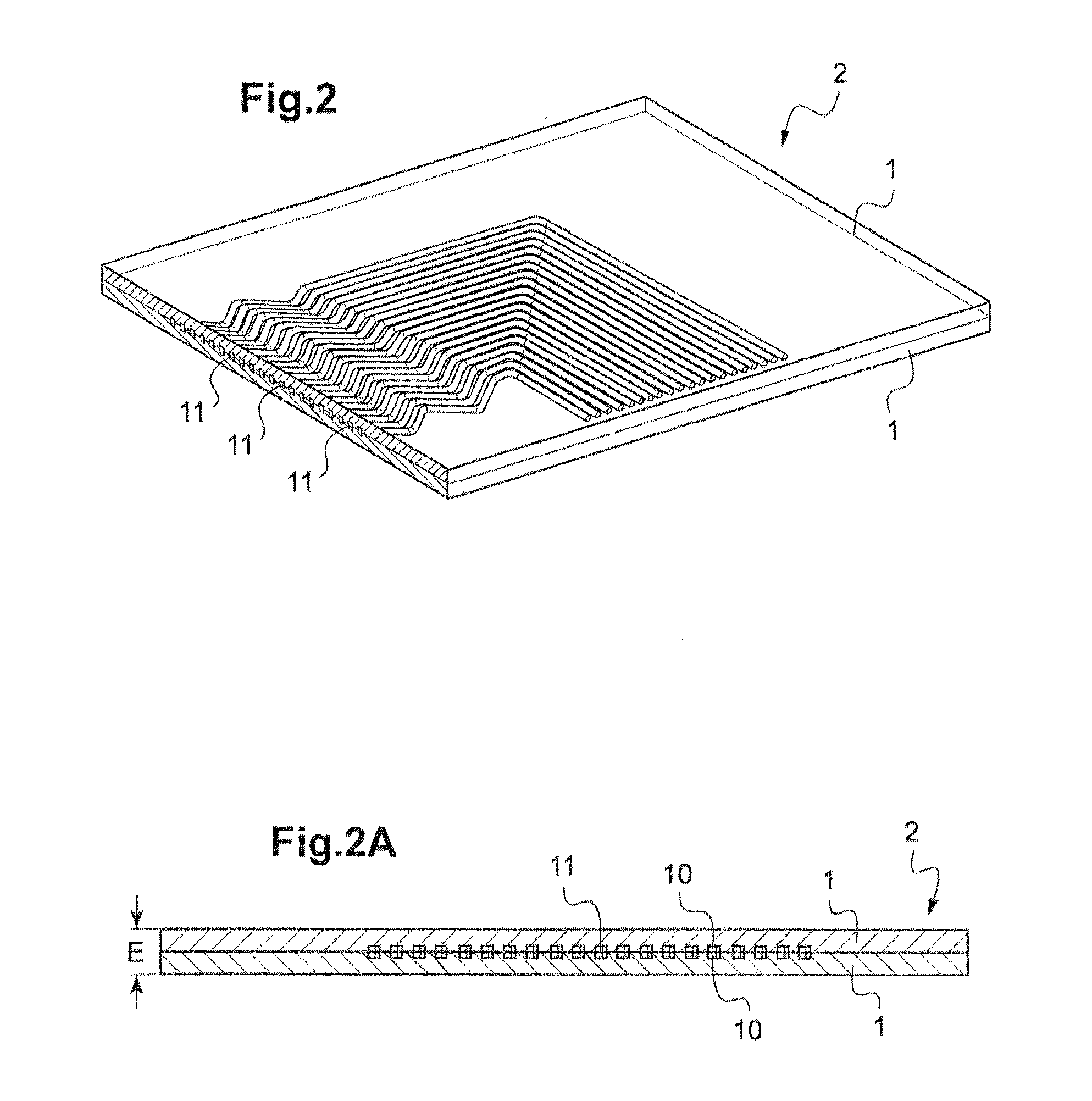Method for producing a heat exchanger module having at least two fluid flow circuits
- Summary
- Abstract
- Description
- Claims
- Application Information
AI Technical Summary
Benefits of technology
Problems solved by technology
Method used
Image
Examples
example 1
[0092]Step a / : In order to produce an element 2 of a first fluid circuit C1, two mutually identical metal plates 1 are produced having rectangular shapes L*1 and a thickness H, grooves 10 having a depth H1, a width 11 and specific spacing e (FIGS. 1, 1A, 1B). The processing operations of the grooves of the two plates 1 are carried out in accordance with two patterns in a mirror image of each other: as illustrated in FIG. 1, these may advantageously be zig-zag patterns with bends of 90° and inclinations of 45° relative to the longitudinal axis X of the plates 1.
[0093]By way of example, the plates 1 are of stainless steel 1.4404, the dimensions L*1*H of a plate 1 are equal to 602*150*4 mm, the dimensions H1*11 of the grooves are equal to 1*2 mm with tolerances which are equal to ±0.02 mm and ±0.05 mm, respectively, the radii of curvature of the grooves R0, R1, R2 are equal to 0.3 mm, 0.1 mm and 2.1 mm, respectively, the distance e between two consecutive grooves, that is, the width of...
example 2
[0117]The same steps are carried out as for the example 1, with the difference that, in addition, the main faces of the eleven elements 2 of the first circuit C1 are processed until the wall thickness between the base of the grooves 10 and the exterior is equal to half the desired thickness between each of the two circuits C1, C2.
[0118]A stack 5 is produced by interposing between the eleven elements 2 of the first fluid circuit C1 the twelve elements 30, 4 of the second fluid circuit which have been produced and processed in accordance with the same principle.
[0119]Then, the periphery of the planar faces obtained in this manner is welded, they are degasified and a high-pressure HIP cycle is applied at 1080° C. at 1000 bar for 3 hours.
example 3
[0120]The same steps are carried out as for example 1, with the difference that, in addition, the main faces of the eleven elements 2 of the first circuit C1 are processed until the wall thickness between the base of the grooves 10 and the outer side is equal to half of the desired thickness between each of the two circuits.
[0121]There are ten elements of the second fluid circuit C2 in this instance which are each constituted by a sheet 6 which is itself constituted by square rectified tubes 60 which are arranged parallel with each other and two bars 7 of the same thickness as the tubes, which are added parallel with the tubes at each side of the sheet 6 (FIG. 6). The outer dimensions of a sheet 6, that is, the width and the length, are equal to those of a grooved plate 1 which constitutes an element 2 of the first circuit C1.
[0122]A stack is then produced by interposing between two consecutive elements 2 of the first circuit C1 a sheet 6 of rectified square tubes 60 which are butt-...
PUM
| Property | Measurement | Unit |
|---|---|---|
| Temperature | aaaaa | aaaaa |
| Temperature | aaaaa | aaaaa |
| Pressure | aaaaa | aaaaa |
Abstract
Description
Claims
Application Information
 Login to View More
Login to View More - R&D
- Intellectual Property
- Life Sciences
- Materials
- Tech Scout
- Unparalleled Data Quality
- Higher Quality Content
- 60% Fewer Hallucinations
Browse by: Latest US Patents, China's latest patents, Technical Efficacy Thesaurus, Application Domain, Technology Topic, Popular Technical Reports.
© 2025 PatSnap. All rights reserved.Legal|Privacy policy|Modern Slavery Act Transparency Statement|Sitemap|About US| Contact US: help@patsnap.com



